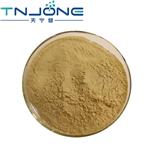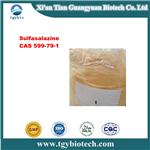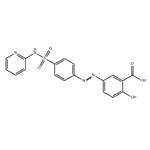- Sulfasalazine
-

- $0.00 / 1kg
-
2024-04-07
- CAS:599-79-1
- Min. Order: 1kg
- Purity: 99%
- Supply Ability: 1000kg
- Sulfasalazine
-

- $85.00 / 1Kg/Bag
-
2023-12-19
- CAS:599-79-1
- Min. Order: 1Kg/Bag
- Purity: 98%
- Supply Ability: 2500kg/month
- Sulfasalazine
-

- $0.00 / 1Kg
-
2023-06-28
- CAS:599-79-1
- Min. Order: 1Kg
- Purity: 99%;USP/EP/CP
- Supply Ability: 1-10000kgs
|
| | Sulfasalazine Chemical Properties |
| Melting point | 260-265 °C (dec.)(lit.) | | Boiling point | 689.3±65.0 °C(Predicted) | | density | 1.3742 (rough estimate) | | refractive index | 1.6000 (estimate) | | storage temp. | Keep in dark place,Sealed in dry,Room Temperature | | solubility | NH4OH 1 M: 50 mg/mL, clear, red | | pka | pKa 0.6(H2O
t = 20
I < 0.001) (Uncertain);2.4(H2O
t = 20
I < 0.001) (Uncertain);9.7(H2O
t = 20
I < 0.001) (Uncertain);11.8(H2O
t = 20
I < 0.001) (Uncertain) | | form | powder | | color | Orange | | Water Solubility | <0.1 g/100 mL at 25 ºC | | Merck | 14,8942 | | BRN | 356241 | | BCS Class | 2,4 | | Stability: | Stable for 1 year from date of purchase as supplied. Solutions in DMSO may be stored at -20° for up to 1 month. | | InChIKey | NCEXYHBECQHGNR-QZQOTICOSA-N | | CAS DataBase Reference | 599-79-1(CAS DataBase Reference) | | IARC | 2B (Vol. 108) 2016 | | EPA Substance Registry System | Salicylazosulfapyridine (599-79-1) |
| | Sulfasalazine Usage And Synthesis |
| Brand Name(s) | Azulfidine (Salazopyrin in Canada)
| | Description | Sulfasalazine (brand name Azulfidine in the U.S., Salazopyrin and Sulazine in Europe and Hong Kong) was developed in the 1950s specifically to treat rheumatoid arthritis. It was believed at the time that bacterial infections were the cause of rheumatoid arthritis. Sulfasalazine is a sulfa drug, (a derivative of mesalazine) and is formed by combining sulfa pyridine and salicylate with an azo bond. It may be abbreviated SSZ. | | Chemical Properties | Brownish-Yellow Crystals | | Uses | Sulfasalazine is an anti-inflammatory (gastrointestinal). Sulfasalazine has been used in granulomatous colitis. | | Uses | An inhibitor of of GSH-H-transferase and NF-kB activation and an apoptosis inducer | | Uses | anticolitis and Crohn's disease | | Uses | Anti-inflammatory (gastrointestinal). Has been used in granulomatous colitis. | | Uses | Sulfasalazine is a prodrug of the anti-inflammatory agent 5-aminosalicylic acid that is covalently linked to the antibiotic sulfapyridine by an azo bond. This bond is rapidly cleaved by bacteria in the terminal ileum and colon, thus releasing the active anti-inflammatory component. It has long been used in treatment of inflammatory bowel disease and rheumatoid arthritis because of its ability to induce T lymphocyte apoptosis, modulate inflammatory mediators from both cyclooxygenase/5-lipoxygenase pathways and NF-κB signaling pathways, attenuate transcription of proinflammatory cytokines, and activate PPARγ.[Cayman Chemical] | | Indications | Sulfasalazine (Azulfidine) was first introduced in 1940
as a treatment for rheumatoid arthritis. It was found
that a number of patients with coexistent inflammatory
bowel disease showed improvement of their GI symptoms,
and the drug has subsequently been used for the
treatment of patients with inflammatory bowel disease. | | Indications | Sulfasalazine (Azulfidine) is approved for the treatment
of rheumatoid arthritis and ulcerative colitis. It is also
used to treat ankylosing spondylitis and Crohn’s disease.
Comparisons of sulfasalazine with other DMARDs suggest
that it is more effective than hydroxychloroquine,
azathioprine, and oral gold compounds. It is at least as
effective as intramuscular gold and penicillamine. It has
a greater degree of toxicity than hydroxychloroquine
but less than gold compounds and penicillamine. After 5
years, approximately 75% of patients have discontinued
sulfasalazine therapy, primarily because of a lack of efficacy
as opposed to intolerable side effects. | | Definition | ChEBI: An azobenzene consisting of diphenyldiazene having a carboxy substituent at the 4-position, a hydroxy substituent at the 3-position and a 2-pyridylaminosulphonyl substituent at the 4'-position. | | Indications | Sulfasalazine is used in the treatment of inflammatory bowel disease, including ulcerative colitis and Crohn's disease. It is also indicated for use in rheumatoid arthritis and used in other types of inflammatory arthritis (e.g. psoriatic arthritis) where it has a beneficial effect. It is often well tolerated compared to other DMARDS.
In clinical trials for the treatment of chronic alcoholics, sulfasalazine has been found to reverse the scarring associated with cirrhosis of the liver .
Cells called myofibroblasts, which contribute to scar tissue in a diseased liver, also appear to secrete proteins that prevent the breakdown of the scar tissue. Sulfasalazine appears to retard this secretion. | | General Description | Odorless yellow or brownish-yellow to orange powder. Tasteless. | | General Description | Sulfasalazine (Azufidine) is an azo prodrug that is reducedby the bacterium present in the lower intestine to its activemetabolites, sulfapyridine and 5-aminosalicylic acid (5-ASA or mesalamine). It has been used for the treatment ofRA or ankylosing spondylitis, and inflammatory bowel diseases(IBDs) such as ulcerative colitis and Crohn disease.It is generally agreed that the therapeutic effects of sulfasalazinein treating IBDs are due mainly through its activemetabolite, 5-ASA. 5-ASA is believed to work, via similarmechanisms of action to the salicylates discussed earlier, byblocking prostaglandin synthesis in the lower intestine. On the other hand, because 5-ASA is completelyionized and very little of this metabolite can enter into systemiccirculation, the antirheumatic effects of sulfasalazinehave been attributed to its other active metabolite, sulfapyridine. In a more recent study, sulfasalazine and sulfapyridinewere found to inhibit 5-aminoimidazole-4-carboxamideribonucleotide transformylase, an enzyme involved in denovo purine biosynthesis. Sulfasalazine also inhibits neutrophilfunction, reduces immunoglobulin levels, and interfereswith T-cell function via suppression of NF-κB activation. Furthermore, like methotrexate, sulfasalazine hasalso been shown to inhibit osteoclastogenesis, thereby preventingbone erosion in arthritic patients.
It should be pointed out that approximately one third of thepatients treated long term with sulfasalazine discontinued thedrug because of dose-related adverse effects including nausea,dyspepsia, vomiting, headache, rash, gastric distress, especiallyin patients on a daily dosage of greater than 4 g (or aserum sulfapyridine levels above 50 mg/mL). | | Air & Water Reactions | Light sensitive and may be sensitive to prolonged exposure to air. Dust can be explosive when suspended in air at specific concentrations. Insoluble in water. | | Fire Hazard | Flash point data for Salicylazosulfapyridine are not available; however, Salicylazosulfapyridine is probably combustible. | | Pharmaceutical Applications | One of the earliest and most successful sulfonamides to be
developed was sulfapyridine, which fell into disuse because
of unwanted effects such as crystalluria. Later, a number of
salicylazosulfonamides, developed because of their increased
water solubility, showed anti-inflammatory properties; one of
them, sulfasalazine (salicylazosulfapyridine), has come into
general use for ulcerative colitis.
After oral administration, some intact compound is
absorbed from the upper gastrointestinal tract, appearing in
the blood in 1–2 h, but most is cleaved by colonic bacteria
to yield sulfapyridine and 5-aminosalicylic acid (mesalamine,
mesalazine). Controlled trials have confirmed the efficacy of
5-aminosalicylic acid alone in ulcerative colitis, the sulfonamide
component merely acting as a carrier. Thus, in remarkable
extension of the good fortune that attended the discovery
of sulfanilamide as the unexpected active principle of Prontosil, a cleavage product appears to be responsible for
the beneficial effect of sulfasalazine. Since most of the side
effects associated with sulfasalazine are attributable to sulfapyridine,
there seems little reason, other than cost, to use it
in preference to mesalamine.
Sulfasalazine is also of benefit in Crohn’s disease and rheumatoid
arthritis, but the role, if any, of sulfapyridine in the
overall effect is unclear. | | Mechanism of action | Sulfasalazine is composed of sulfapyridine and 5-
ASA molecules linked by an azo bond. Sulfapyridine
has no effect on the inflammatory bowel disease, and instillation
of this agent into the colon does not heal
colonic mucosa. | | Pharmacology | Sulfasalazine is a prodrug of which 70% is converted
by colon bacteria to two active metabolites, sulfapyridine
and 5-aminosalicylic acid (mesalamine). Sulfapyridine
has antibacterial activities, and 5-aminosalicylic
acid is antiinflammatory; however, these effects do
not account for the ability of this drug to slow the
processes of rheumatoid arthritis. Recent research suggests
additional activities of sulfasalazine that may be
relevant to these effects: its ability to increase adenosine
levels, its inhibitory effects on IL-1 and TNF-
release, and its inhibition of NF-κB. | | Pharmacokinetics | sulfasalazine is poorly absorbed, with approximately 20% of the ingested sulfasalazine
reaching the systemic circulation. The remainder of the ingested dose is metabolized by colonic bacteria into its
components, sulfapyridine and mesalamine (5-ASA). Most of the sulfapyridine metabolized from sulfasalazine
(60–80%) is absorbed in the colon following oral administration, and approximately 25% of the 5-ASA metabolized
from sulfasalazine is absorbed in the colon. | | Clinical Use | Sulfasalazine (Azulfidine) was first introduced in 1940
as a treatment for rheumatoid arthritis. | | Clinical Use | Sulfasalazine (2-hydroxy-5[[4-[(2-pyridinylamino)sulfonyl]phenyl]azo]benzoic acid or 5-[p-(2-pyridylsulfamoyl)phenylazo]salicylic acid) is a brownish yellow, odorlesspowder, slightly soluble in alcohol but practically insolublein water, ether, and benzene.
Sulfasalazine is broken down in the body to m-aminosalicylicacid and sulfapyridine. The drug is excreted throughthe kidneys and is detectable colorimetrically in the urine,producing an orange-yellow color when the urine is alkalineand no color when the urine is acid. | | Side effects | Sulfsalazine metabolizes to sulfa pyridine. Serum levels should be monitored every three months, and more frequently at the outset. Serum levels above 50 μg / l are associated with side effects. In rare cases, Sulfasalazine can cause severe depression in young males. It can also cause temporary infertility. Immune thrombocytopenia has been reported.
Sulfasalazine inhibits dihydrofolate reductase, and can cause folate deficiency and megaloblastic anemia.
Sulfasalazine can cause hemolytic anemia in people with G6PD deficiency. | | Side effects | Mild to moderate side effects, including nausea, vomiting,
abdominal pain, diarrhea, anorexia, and headache,
occur in up to 33% of patients taking this drug. Skin
rash and discoloration, fever, reversible male infertility,
and liver enzyme elevation occur less frequently. Rare
hematological abnormalities, such as agranulocytosis,
aplastic anemia, hemolytic anemia, neutropenia, or
other blood dyscrasias, can be fatal. Hypersensitivity reactions
occur rarely. | | Side effects | It is, however, responsible for most of
sulfasalazine’s side effects, including sulfa allergic reactions.
5-ASA, the active metabolite, may inhibit the synthesis
of mediators of inflammation. | | Synthesis | Sulfasalazine, 5-[p-[(4,6-dimethyl-2-pyridinyl)sulfamoyl]phenylazo]sali�cylic acid (33.1.22), is a derivative of sulfapyridine drug described above and one of the
few sulfanilamides in which the free amino group in the benzene ring is modified, and it
is synthesized by an azo-coupling reaction of a diazo salt, which is synthesized by react�ing sulfapyridine (33.1.21) with nitrous acid and salicylic acid alkaline media. 
| | Veterinary Drugs and Treatments | Sulfasalazine is used for the treatment of inflammatory bowel disease
in dogs and cats. It has also been suggested for adjunctive use
in treating vasculitis in dogs. | | Drug interactions | Potentially hazardous interactions with other drugs
Ciclosporin: may reduce ciclosporin levels. | | Metabolism | After cleavage of the sulfasalazine molecule about 60 to
80% of available sulfapyridine is absorbed, and undergoes
extensive metabolism in the liver by acetylation,
hydroxylation, and glucuronidation.
Most of a dose of sulfasalazine is excreted in the urine.
Unchanged sulfasalazine accounts for 15% of the original
dose, sulfapyridine and its metabolites 60%, and 5-ASA
and its metabolites 20-33%. | | storage | Store at RT | | Mode of action | Sulfasalazine, and its metabolite 5-ASA, are poorly absorbed from the gut. Its main mode of action is therefore believed to be inside the intestine.
Bowel disease
In Crohn's disease and ulcerative colitis, it is thought to be an antinflammatory drug that is essentially providing topical relief inside the intestine. It does this via a number of mechanisms such as reducing the synthesis of inflammatory mediators known as eicosanoids and inflammatory cytokines. However, unlike glucocorticoids ( another class of drug used in the treatment in inflammatory bowel disease ), sulfasalazine is a mild immunosuppressant.
Arthritis
When treatment for arthritis is successful, pain, joint swelling and stiffness will be reduced and this may slow down or stop the development of joint damage. The precise reasons why sulfasalazine are effective in various forms of arthritis is not clearly understood. Because sulfasalazine and its metabolite 5-ASA are poorly absorbed into the bloodstream, it is surprising that the drug is effective against symptoms outside of the intestine. One possible explanation is that, given that ulcerative colitis produces arthritic symptoms, the arthritic symptoms are actually a product of unrecognized ulcerative colitis , which is effectively treated with sulfazalazine. | | Precautions | Sulfasalazine is contraindicated in individuals with hypersensitivityto salicylates, sulfonamides, sulfonylureas,and certain diuretics (furosemide, thiazides, andcarbonic anhydrase inhibitors). Because it can causekernicterus, sulfasalazine is contraindicated in infantsand children under 2 years of age. Sulfasalazine passesinto breast milk and is therefore contraindicated fornursing mothers. Similarly, pregnant women near termshould not use this drug, although it appears to be thesafest of the DMARDs during early pregnancy.Sulfasalazine can precipitate attacks of porphyria andshould not be used by individuals with bowel or urinaryobstruction.
Sulfasalazine can inhibit the absorption of cardiacglycosides and folic acid. It may displace certain drugs,including warfarin, phenytoin, methotrexate, tolbutamide,chlorpropamide, and oral sulfonylureas, fromtheir protein binding sites. Sulfasalazine can diminishthe effectiveness of penicillins and estrogen-containingoral contraceptives. | | References | 1) Peppercorn (1984),?Sulfasalazine. Pharmacology, clinical use, toxicity, and related drug development; Ann. Intern. Med.,?101?377
2) Wahl?et al. (1998),?Sulfasalazine: a potent and specific inhibitor of nuclear factor kappa B; J. Clin. Invest.,?101?1163
3) Sheldon?et al. (1988),?Effect of sulphasalazine and its metabolites on mitogen induced transformation of lymphocytes D clues to its clinical action?; Br. J. Rheumatol.,?27?344
4) Fujiwara?et al. (1990),?Inhibition of proliferation responses and interleukin 2 production by salazosulfapyridine and its metabolites; Jpn. J. Pharmacol.,?54?121
5) Chung and Sontheimer (2009),?Sulfasalazine inhibits the growth of primary brain tumors in dependent of nuclear factor-κB; J.Neurochem.,?110?182
6) Patel?et al. (2004),?Differentiation of substrate and non-substrate inhibitors of transport system Xc – :an obligate exchanger of L-glutamate and L-cystine; Neuropharmacol.,?46?273 |
| | Sulfasalazine Preparation Products And Raw materials |
|